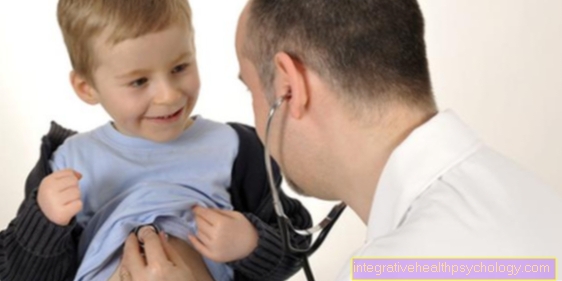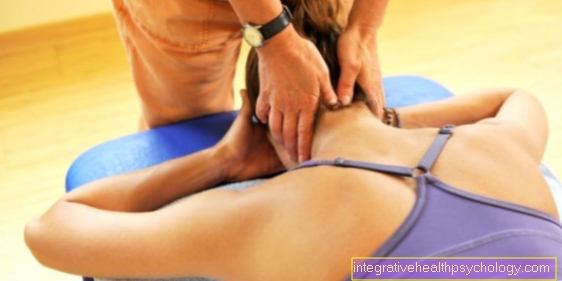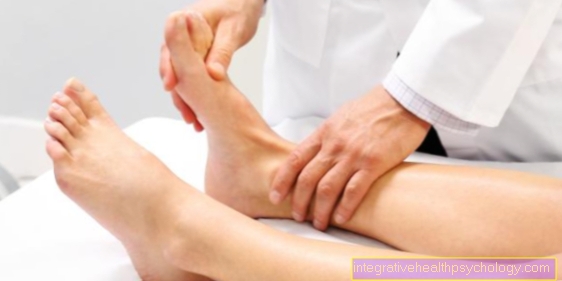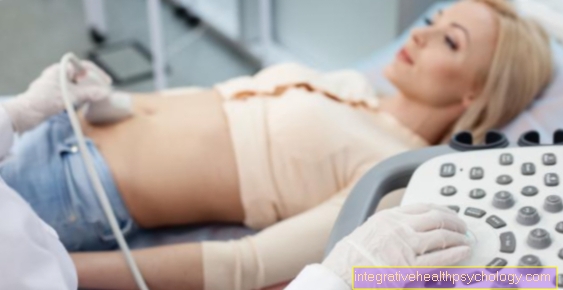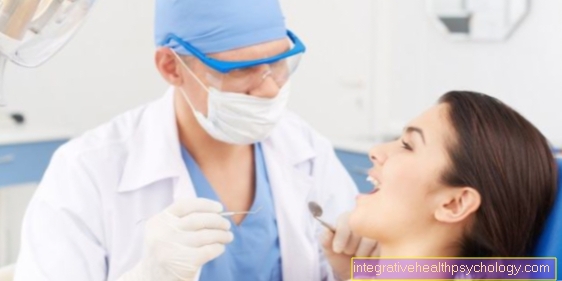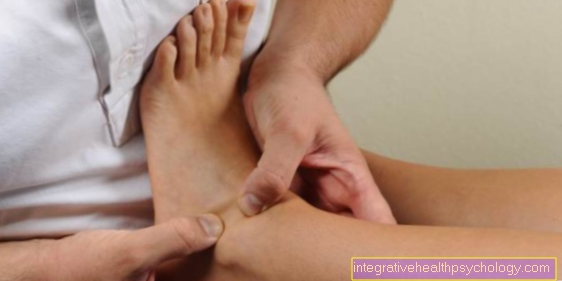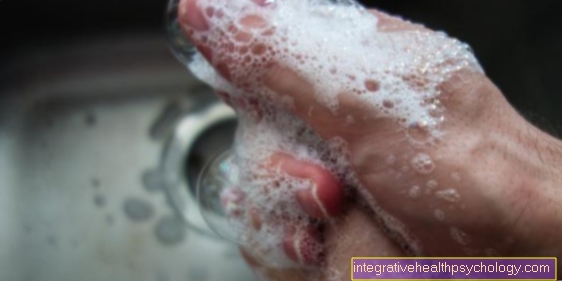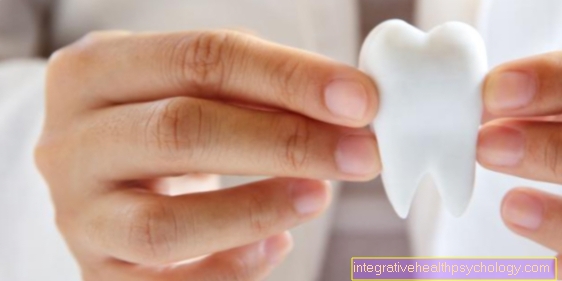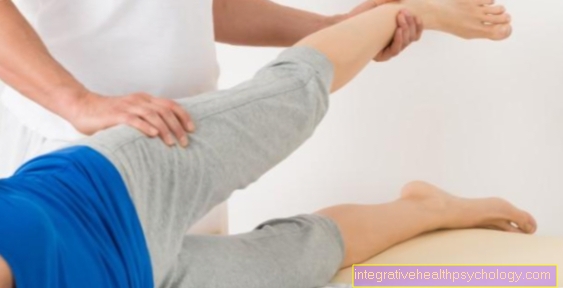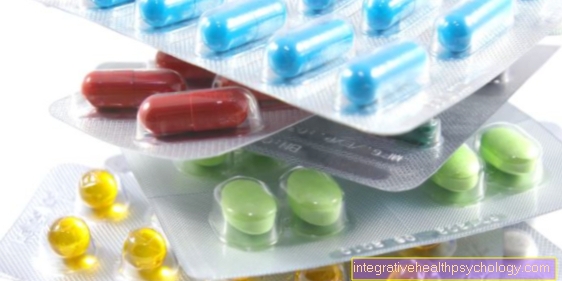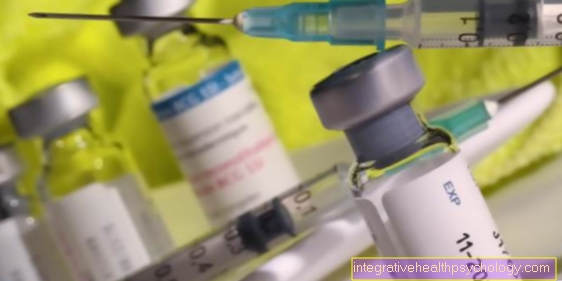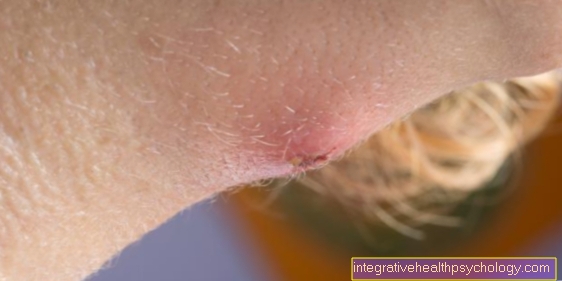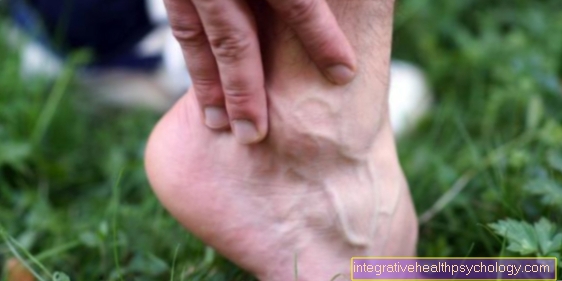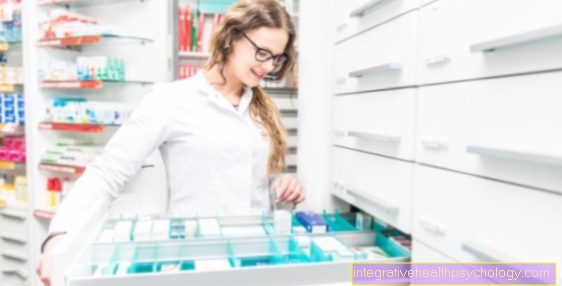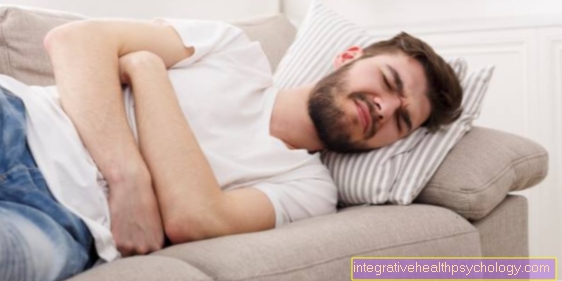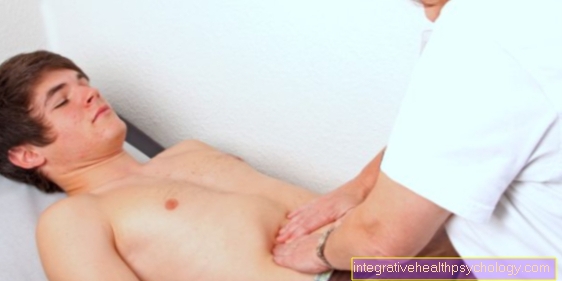Pus on the abdomen
What is a pus pimple on the stomach?
Pus pimples on the abdomen are skin symptoms that occur in the abdominal region or in the navel itself. In some cases they spread to other parts of the body. They can give off a watery secretion, cause itching or pain.
The cause can be harmless, have no disease value and therefore require no (medical) treatment. The pus pimples on the stomach can also be an expression of a disease or an allergy, which requires appropriate (medical) measures.
First, read the main pus pimple article to be sure of the basics: Pus pimples - what to do?

Causes of pus pimples on the abdomen
Pus pimples on the abdomen can have a variety of causes. In principle, they develop in the same way as all other pimples on the body. Their formation is based on the behavior of the sebum glands or an oversupply of sebum. Normally the sebum glands produce sebum, which is transported away through the open pores of the skin. However, if dead skin particles do not fall off the skin, cornification occurs. This causes the skin pores to clog. The sebum can no longer be adequately removed. This can lead to bacterial inflammation, which manifests itself as a pus pimple on the skin.
In addition, an unbalanced diet or lifestyle can cause pus pimples on the abdomen and other parts of the body.
It is also possible that they occur as part of an allergic reaction. The allergy-causing substances can be found in new, not yet laundered clothing. As a rule, there are certain surfactants that are present in the clothing and are released through body sweat. This can result in pus pimples on the abdomen. In addition, the allergens can be present in detergents and thus get on the skin.
In addition, a nickel allergy can trigger pimples on the stomach. Nickel is often contained in the trouser button and belt buckle. The nickel ions are drawn out of the metal by body sweat and can cause skin symptoms. This contact allergy affects around every 100th man and every 10th woman. A contact allergy can also be caused by navel piercings.
Furthermore, pimples on the stomach can be caused by certain medications, hormonal fluctuations, food, cold, pressure or heat. In addition, pus pimples on the stomach can appear as a late reaction to vaccinations, fungal infections, certain illnesses and bites from fleas, mites, bed bugs and various insects.
In addition, pus pimples can develop on the stomach when those affected shave their stomach. Shaving can irritate the skin of the abdomen, causing it to become infected and pus pimples to develop.
Another cause of pimples is oily skin. You can find out how this occurs and how you should act with oily skin at: Oily skin and pimples
Treatment of pus pimples on the abdomen
Treatment for pus pimples on the abdomen depends on the cause.
If allergens in clothing, food, detergent or medication caused the pimples, these must be avoided accordingly.
If mites have triggered symptoms, various therapeutic measures are required. In addition to treating the person affected, it is important to identify and treat the contact persons. A certain species of mite (S. norvegica) requires hospitalization with isolation of the person concerned. Protective measures taken by the nursing staff are also important here. The bed linen and towels must be changed daily. In addition, the room and objects in the room must be disinfected daily.
In S. norwegica, the affected person is usually 5-10% Salicylic petroleum jelly pretreated. For all types of mites is for basic therapy Permethrin 1st choice means. A 5% cream is recommended for children and adults. A 2.5% cream is advisable for newborns up to 3 months of age. The cream is applied once for 8-12 hours. This measure is repeated after 2 weeks. Alternatively, in some cases Crotamiton and Bezyl benzoate applied. Used for oral therapy Ivermectin recommended. The amount depends on the body weight: 200-400 µg / kg body weight.
If the treatment is inadequate, symptoms can recur. After healing, a persistent, very itchy rash on the abdomen and other parts of the body may occur. This complication is known in technical jargon as postcabbyous eczema designated. It is important to interrupt the itching and scratching cycle. Come here Cortisone supplements, polidocanol cream, and antihistamines for use.
If the pimples on the stomach are caused by fleas, symptomatic therapy is recommended. In some cases, antiseptic or corticosteroid creams are used. The bottom line of treatment is that sooner or later the flea must be caught.
Symptomatic treatment is also provided for bed bug infestations, for example with antihistamines or steroids.
If the pimples on the stomach are caused by a fungal infection, antifungal agents are used. In addition, thorough hygiene and disinfection must be carried out in these cases.
In infants and young children, severely itchy heat rashes can cause a low-concentration cortisone ointment and antihistamines be treated.
If the pimples occur as part of a pregnancy prurigo, they are mostly moist compresses, UV radiation, and medicines to relieve itching recommended.
If the pimples on the abdomen were caused by shaving, symptomatic and prophylactic treatment is advisable. This means that the next time you shave, you should shower your stomach cold. This closes the skin pores and reduces the risk of inflammation. You should pay attention to good razor blades, which irritate the skin less, and then apply a well-tolerated skin cream to the treated area.
If the causal childhood diseases are involved, appropriate measures must be taken.
You can also find helpful information regarding treatment in the following articles:
- Skin Fungus - What To Do?
- Rash from mites
- Mites in bed - this helps best
How long does it take for a pus pimple to go away?
The duration of the pimples on the stomach depends on the cause.
In the case of harmless causes, the symptoms usually only last a few days.
In the case of mite, flea or bed bug infestation, the healing process can take a few weeks and in some cases months or recur. A flea that is not caught can survive with the affected person for 1.5 years - like a kind of pet.
Pus pimples on the abdomen in the child
In children, pimples on the stomach are often caused by heat or childhood illnesses.
The heat rash occurs when there is a blockage of the sweat glands when sweating heavily. This happens more often in small children, as their skin pores are not yet fully developed. These heat rashes tend to occur with (too) warm clothing, high humidity and high temperatures. Often these cause severe itching. This must be treated adequately, otherwise permanent skin damage can result from scratching.
In a differential diagnosis, you have to distinguish the heat pimples from the red pimples on the abdomen, which you see Three-day fever occur in infants.
The three-day fever should be treated differently than the pus on the abdomen. For more information, read the articles at:
- Rash in three-day fever
- Is the three-day fever contagious?
Pus pimples on the abdomen during pregnancy
During pregnancy, changes in hormones can cause pimples on the abdomen. A rash with puritic urticarial papules and plaques (PUPP) can develop. This skin change is characterized by reddish, itchy pimples on the stomach. These can also spread to other parts of the body and manifest there. Usually the skin symptoms heal completely after pregnancy.
Some authors suggest that the pimples are caused by immune defense reactions from fetal cells.
In addition, there can be extremely itchy, reddish nodules on the stomach. This skin condition is known as pregnancy prurigo.
The pregnancy pemphigoid must be differentiated from a differential diagnosis. This blistering disease was formerly also called herpes gestationis, as the skin manifestations are herpetiform (= grouped). Differentiation criteria are vesicles that occur in groups. The differential diagnosis and the corresponding adequate treatment must be discussed with a gynecologist.
Further important details about the disease PUPP "puritic urticarial papules and plaques" can be found at: PUPP syndrome
Pus pimples on the navel piercing
A navel piercing can cause intolerance and allergies. This is often a contact allergy. Body sweat can pull substances out of the metal, which can then cause skin symptoms.
A navel piercing can also lead to inflammation, which is responsible for the pimples on the stomach. Since the abdomen is an area of the body that is in great motion, the wound that is created during the procedure is subject to a lot of stress. This means that the wound is also stressed while sitting. Accordingly, the healing process takes longer and the risk of inflammation of the wound is longer. As a rule, a healing time between 3-12 months is assumed.
Every professional piercing studio makes it possible to take advantage of extensive care advice and follow-up examinations when planning a navel piercing. If you are unsure, a doctor should be contacted.
You can read additional information about the navel piercing and its complications at: Belly button piercing is infected - what should I do?
Symptoms of pus on the abdomen
The pus pimples on the abdomen can trigger different symptoms. Depending on the cause, a variety of side effects can express themselves. The pimples themselves and the accompanying symptoms can appear insidious or acute.
The pimples are usually characterized by a slight bump, reddening and a yellowish-whitish spot in the center of the pimple. With ripe pus pimples, pus and / or a watery secretion can evacuate. The pus can leave an unpleasant odor.
They can also cause itching or pain of varying degrees. In addition, there may be swelling of the abdominal region. In addition, fever, general malaise, sweating, nausea, vomiting, coughing, breathing difficulties or swelling of the lymph nodes may occur. The (scratched) pimples can bleed. In addition, the pus pimples can also show on other parts of the body.
Itching when pus on the abdomen
If there are pus pimples on the abdomen, itching can vary in intensity. The itching is caused by various cell-mediated processes in the body. Various messenger substances are released, such as histamine. The cells can communicate with each other through these messenger substances. Finally, the sensory quality of the itching is reported to the brain.
If the pimples are caused by mites, itching at night is typical as the females lay their eggs at night.
Diagnosis of pus pimples on the abdomen
In order to be able to make a diagnosis, it is necessary to interview the person affected and in some cases also the relatives. In technical terms, one speaks of an anamnesis of one's own and others. These surveys make it possible to make first differentiated considerations regarding the causes of the pus pimples on the abdomen.
Then the doctor will look at and feel the abdominal region and, if necessary, other parts of the body. The skin symptoms often give direct indications of possible causes. For example, bed bugs leave characteristic marks on the affected person's skin. Cat fleas also provide typical "characteristics". A kind of pimple roads on the affected skin area are evident, which mark the activity of the flea. In addition, mites leave winding, millimeter-long, palpable mite burrows and mite mounds at the end of the alley. These can often be located in the navel or in the waist area. A flea bite usually shows a three-way configuration of the stitches on the skin.
In addition to a detailed assessment of the pus pimples, further examinations may be necessary depending on the suspected diagnosis. If necessary, a smear is taken or a scale sample is taken if a fungal disease is suspected.
A blood test may also be advisable. An allergy test may need to be done if an allergy is suspected. In addition, childhood diseases in children - and in some adults too - must be ruled out.
Pus on the back
Pus pimples on the back can develop for reasons similar to pimples on the stomach and can occur at the same time. The examination measures and accompanying complaints are similar. Treatment depends on the cause. If the pimples do not go away shortly and other complaints occur, a dermatologist should definitely be consulted.
In general, it is advisable to ensure conscientious, appropriate hygiene. A peeling for the stomach and back can remove dead skin and also stimulate the blood circulation. Home remedies can help with harmless pimples on the stomach and back without any disease value. For example, healing clay, hot compresses, and warm chamomile baths are recommended.
When buying outerwear, fabrics made from pure cotton should be selected if possible. In addition, the lifestyle should be "skin-friendly". This means that you should get enough sleep as possible, on a diet rich in vitamins and nutrients, low in fat and sugar, and exercising enough to stimulate blood circulation in the skin. Alcohol and smoking should be avoided if possible.
At this point, we recommend our main article on the topic: Pus on the back
Recommendation from the editor
Further important information on the subject can also be found at:
- Pus under the skin
- Skin itchy - why?
- Pus in the eye
- Contact dermatitis - how does it develop?
- What's the best skin care product?



